Training Dogs with Love
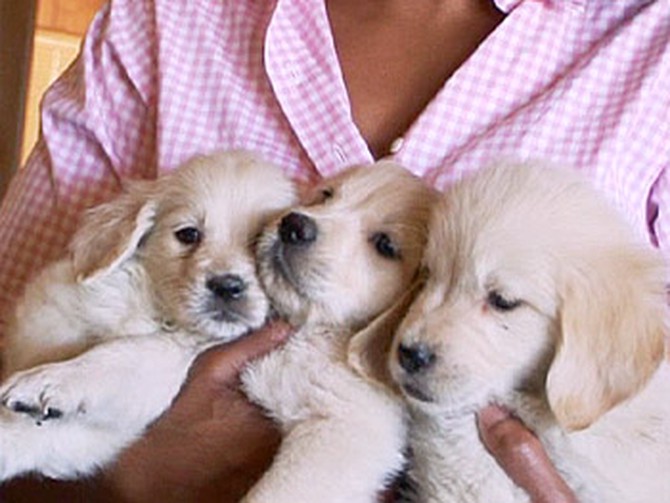
The Oprah Show is going to the dogs! Oprah is sharing her personal dog coach to help all dog lovers learn life-changing lessons.
Oprah and Stedman decided to expand their family—which already included their cocker spaniels, Sophie and Solomon—with two white golden retriever puppies. But once they arrived at the breeder, a third puppy with a lovable overbite captured Oprah's heart. "What's the difference between two and three?" Oprah asked. "Huge," Stedman said.
Oprah and Stedman took Luke, Layla and Gracie home, but Oprah soon found there really was a big difference between two and three pups. Soon, the chewing, biting and pooping got to be too much. "I wanted to do it myself. I wanted to be responsible. I wanted them to bond with me," Oprah says. "And then after about three months, reality had sunk in. My three puppies needed training."
Sadly, Gracie died after a sudden accident when she was two years old.
Oprah and Stedman decided to expand their family—which already included their cocker spaniels, Sophie and Solomon—with two white golden retriever puppies. But once they arrived at the breeder, a third puppy with a lovable overbite captured Oprah's heart. "What's the difference between two and three?" Oprah asked. "Huge," Stedman said.
Oprah and Stedman took Luke, Layla and Gracie home, but Oprah soon found there really was a big difference between two and three pups. Soon, the chewing, biting and pooping got to be too much. "I wanted to do it myself. I wanted to be responsible. I wanted them to bond with me," Oprah says. "And then after about three months, reality had sunk in. My three puppies needed training."
Sadly, Gracie died after a sudden accident when she was two years old.
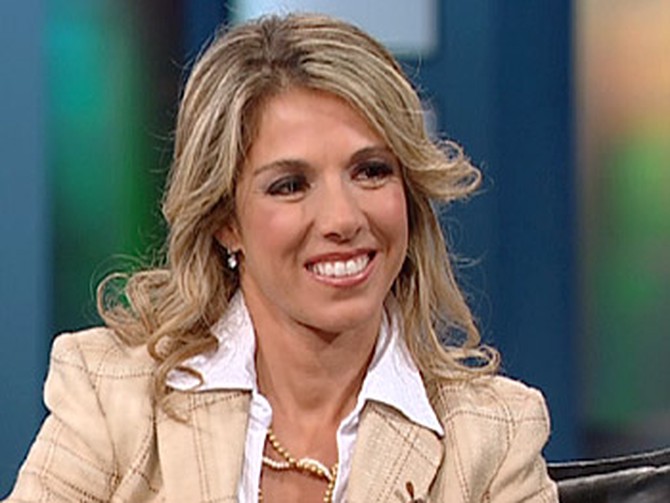
Oprah turned to dog trainer Tamar Geller for help. Born and raised in Israel, Tamar caught a glimpse of dog training while serving a mandatory tour in the Israeli army. During her downtime, Tamar says she watched the special forces train their dogs. "In order to break the spirit of a dog, they would let a dog stand on his back feet for hours on hours," she says. "When they finally let him down, he would collapse. And I was appalled. I did not believe that that's the way to build a relationship with a dog."
After her two years in the army, Tamar headed to the desert to think about her next step. It was there that she met a team of wolf researchers. "What was very striking to me when I was sitting there observing the wolves was to see how loving they are and how they teach their young," she says. "I was blown away. No aggression." Tamar then developed a plan to train dogs based on the wolf behavior she saw.
Today, Tamar uses The Loved Dog method—which emphasizes manners, not obedience. "The main difference between this method and other methods is that I look at dogs and I raise them as if they are a part of the family versus train them and I want them to be submissive and they have to obey," Tamar says. "I want them to be family members. I want them to be able to express who they are."
After her two years in the army, Tamar headed to the desert to think about her next step. It was there that she met a team of wolf researchers. "What was very striking to me when I was sitting there observing the wolves was to see how loving they are and how they teach their young," she says. "I was blown away. No aggression." Tamar then developed a plan to train dogs based on the wolf behavior she saw.
Today, Tamar uses The Loved Dog method—which emphasizes manners, not obedience. "The main difference between this method and other methods is that I look at dogs and I raise them as if they are a part of the family versus train them and I want them to be submissive and they have to obey," Tamar says. "I want them to be family members. I want them to be able to express who they are."
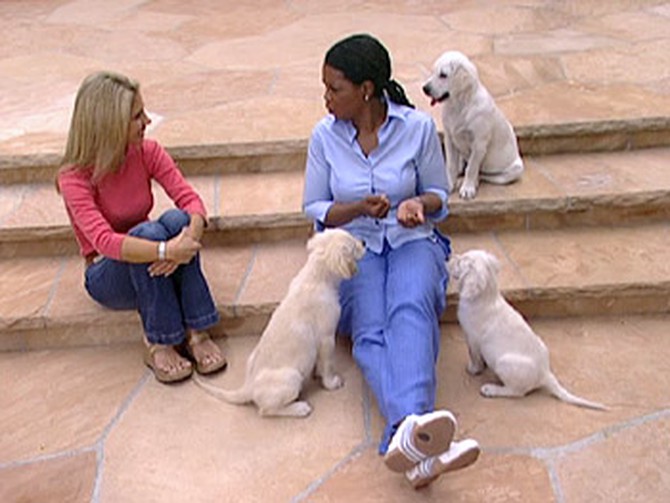
Tamar's sessions with Luke, Layla and Gracie began with the most basic command there is—sit. Tamar says teaching a dog to sit is like teaching a child to say please.
To train the puppies to sit, start with a small treat, which Tamar calls the "magnet." Oprah holds the treat and then uses her hand like a magnet, moving it to where she wants the dog's head to go. "Your attention is the big reward," Tamar says.
When the dog sits, she gets a treat and Oprah says "sit" in a sing-song way. "It's about celebrating it. ... So I want the tone of voice and your smile to be part of the reward," Tamar says. "I don't want you to say 'good girl' because 'good girl' is too generic. How can she repeat doing good girl?"
To train the puppies to sit, start with a small treat, which Tamar calls the "magnet." Oprah holds the treat and then uses her hand like a magnet, moving it to where she wants the dog's head to go. "Your attention is the big reward," Tamar says.
When the dog sits, she gets a treat and Oprah says "sit" in a sing-song way. "It's about celebrating it. ... So I want the tone of voice and your smile to be part of the reward," Tamar says. "I don't want you to say 'good girl' because 'good girl' is too generic. How can she repeat doing good girl?"
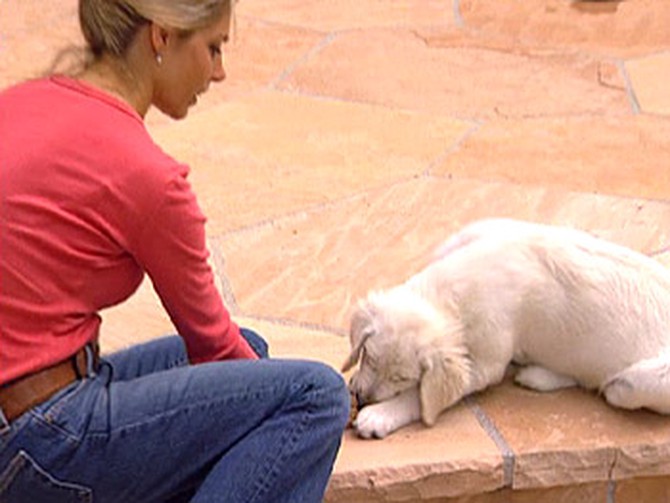
Next, Oprah's dogs learn how to lie down. To start, Tamar says to look at the spot on the floor where you want your dog to go and make a straight line from their nose to the floor while holding a treat and saying "down." Place the treat on the ground, and then stand up and step back after the dog lies down.
Tamar also says to make training seem like a game and act enthusiastic when the dog does something right. "You want to be free," Tamar says. "You want to have fun."
Tamar also says to make training seem like a game and act enthusiastic when the dog does something right. "You want to be free," Tamar says. "You want to have fun."
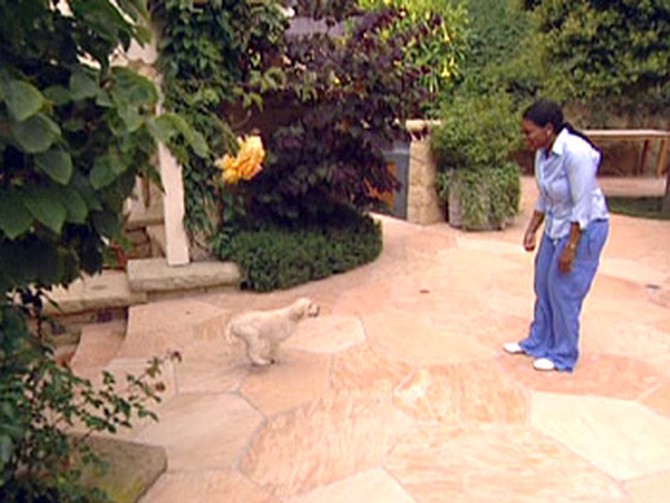
Tamar teaches Oprah to use hide-and-seek to teach her dogs to follow the sound of her voice. Soon, Layla comes when Oprah calls!
Tamar cautions against using the dog's name too often—you should only address them by name when you want their attention. "You teach them that when you say their name, it's worth it for them to listen to you," Tamar says. "If you go all day and you say, 'Luke, Gracie, Layla,' and you're not talking to them, they're going to tune you out."
Tamar cautions against using the dog's name too often—you should only address them by name when you want their attention. "You teach them that when you say their name, it's worth it for them to listen to you," Tamar says. "If you go all day and you say, 'Luke, Gracie, Layla,' and you're not talking to them, they're going to tune you out."
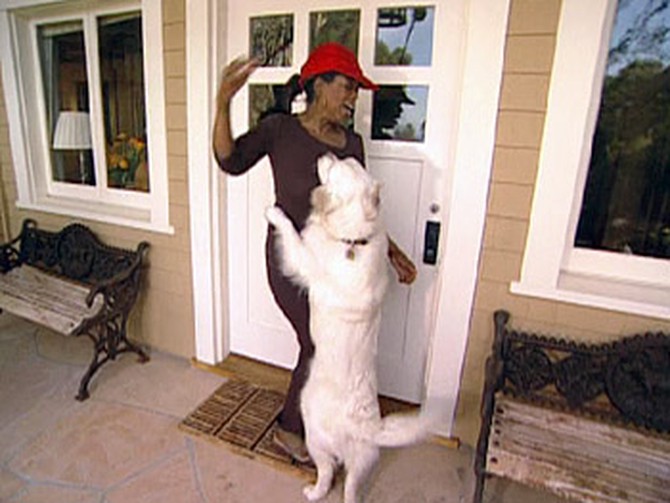
Although Tamar's first sessions with the puppies did wonders for Oprah's
family, Oprah had to call Tamar for help with the number-one problem dog owners
have—jumping.
Whether Oprah's been gone for five minutes or five hours, Luke and Gracie immediately jump on her when she returns. "It's a lot of love, Tamar, but a little too much love because they also do it to strangers," Oprah says.
Tamar says the problem is simple—they just want to be loved. "They are so excited to see the mom that they forget the manners," Tamar says. "They were getting rewarded for behavior that you didn't like because every time they jumped you looked at them, you smiled at them, you petted them so they were like, 'Yes, we want to do it again!'"
 Watch how Oprah's dogs take to Tamar's advice!
Watch how Oprah's dogs take to Tamar's advice!
Tamar has a three-step method to teach Luke, Layla and Gracie to stay on all fours:
Step 1: Turn your back. "I want you to be the center of the universe," Tamar says. "Therefore, I want you to love them so much that when you take the love away they're like, 'Oh, what can we do to get her love back?'"
Step 2: Tell the dog to sit. "I want them to know that the only time you're going to look at them and you're going to touch them is when they're sitting," Tamar says. "I want them to feel like they're exploding, but yet they are not moving their tush off the ground."
Step 3: Give a treat, but make sure to keep your hand low. "If you give your treat [too high], she's going to jump to get it," Tamar says.
Whether Oprah's been gone for five minutes or five hours, Luke and Gracie immediately jump on her when she returns. "It's a lot of love, Tamar, but a little too much love because they also do it to strangers," Oprah says.
Tamar says the problem is simple—they just want to be loved. "They are so excited to see the mom that they forget the manners," Tamar says. "They were getting rewarded for behavior that you didn't like because every time they jumped you looked at them, you smiled at them, you petted them so they were like, 'Yes, we want to do it again!'"
Tamar has a three-step method to teach Luke, Layla and Gracie to stay on all fours:
Step 1: Turn your back. "I want you to be the center of the universe," Tamar says. "Therefore, I want you to love them so much that when you take the love away they're like, 'Oh, what can we do to get her love back?'"
Step 2: Tell the dog to sit. "I want them to know that the only time you're going to look at them and you're going to touch them is when they're sitting," Tamar says. "I want them to feel like they're exploding, but yet they are not moving their tush off the ground."
Step 3: Give a treat, but make sure to keep your hand low. "If you give your treat [too high], she's going to jump to get it," Tamar says.
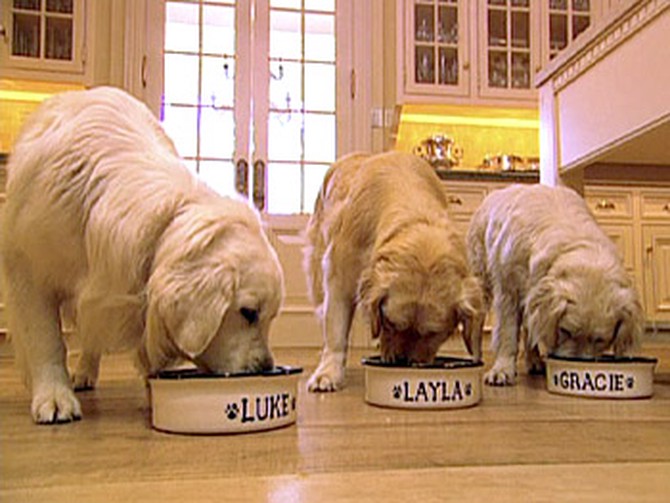
In Oprah's house, dinner doesn't begin until the dogs have shown her that they have impeccable table manners! "We're not allowed to come running into the room until we sit and we ask for it," Oprah says.
When it's time for dinner—usually rice, carrots and beef—Oprah first has each dog sit. Then, Oprah says "wait" as they remain seated and they show her their good manners. "Sitting down is like saying, 'Please, may I eat?'" Oprah says. Finally, the dogs each find their own bowls and chow down!
"I believe give as much love as you want as long as you have boundaries," Tamar says. "I want a dog to look at the owner and say, 'How did I get so lucky?' Because the owner is demanding respect."
When it's time for dinner—usually rice, carrots and beef—Oprah first has each dog sit. Then, Oprah says "wait" as they remain seated and they show her their good manners. "Sitting down is like saying, 'Please, may I eat?'" Oprah says. Finally, the dogs each find their own bowls and chow down!
"I believe give as much love as you want as long as you have boundaries," Tamar says. "I want a dog to look at the owner and say, 'How did I get so lucky?' Because the owner is demanding respect."
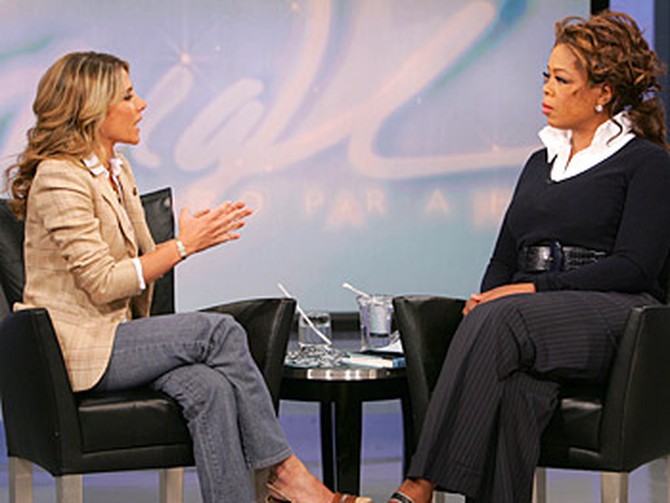
Tamar uses a lot of treats while training, but she says most dog owners make common mistakes when it comes to rewarding their pups. Depending on the task at hand, dog owners might be giving too many or not giving enough. "The dog remembered or learned to sit a year ago and you gave him a jackpot for sitting. It's kind of like you don't get excited when your 20-year-old knows what two and two is," Tamar says. "So you need to give the reward in proportion to what they accomplished. Just like you do with salaries. Just like you do with allowance."
In the beginning, Tamar says to use just a little bit to get them to first respond to a reward. Then, she recommends gradually eliminating the treats once the dog has a handle on the command.
In the beginning, Tamar says to use just a little bit to get them to first respond to a reward. Then, she recommends gradually eliminating the treats once the dog has a handle on the command.
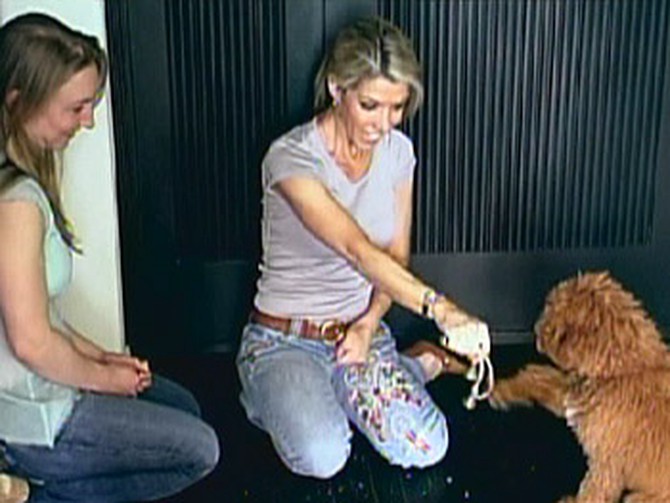
When you bring home a new puppy, a mess is guaranteed to follow. Tamar has a three-step approach to potty training your pooch. "Really, what housebreaking is about is teaching her how to hold it and then teaching her how to let you know that she needs to go out," Tamar says. "It just takes repetition."
Step 1: Set up a cozy crate. Tamar says to keep your puppy in a crate for part of the day. "After three times of being in her own mess she's going to say 'Ew' and she's going to hold it," Tamar says.
Step 2: Set up a schedule. Every two hours, let your puppy out. "You give him water right before you take him outside," Tamar says. "And then when he's going to go to the bathroom, say, 'Do your business. Go potty.' Whatever you choose to call it." As your puppy gets more used to the pattern, Tamar recommends increasing free time outside of the crate.
Step 3: Teach your dog to let you know when it's time to go out. One way to do so, Tamar says, is to teach them to ring a bell. Hold the bell in your hand, and reward the dog if they touch it with their paw or nose. Every time your dog rings the bell, immediately take them outside. "It's kind of like Pavlov. You ring the bell, they start salivating," Tamar says. "We teach her, you ring the bell, you're going to be let out."
Step 1: Set up a cozy crate. Tamar says to keep your puppy in a crate for part of the day. "After three times of being in her own mess she's going to say 'Ew' and she's going to hold it," Tamar says.
Step 2: Set up a schedule. Every two hours, let your puppy out. "You give him water right before you take him outside," Tamar says. "And then when he's going to go to the bathroom, say, 'Do your business. Go potty.' Whatever you choose to call it." As your puppy gets more used to the pattern, Tamar recommends increasing free time outside of the crate.
Step 3: Teach your dog to let you know when it's time to go out. One way to do so, Tamar says, is to teach them to ring a bell. Hold the bell in your hand, and reward the dog if they touch it with their paw or nose. Every time your dog rings the bell, immediately take them outside. "It's kind of like Pavlov. You ring the bell, they start salivating," Tamar says. "We teach her, you ring the bell, you're going to be let out."
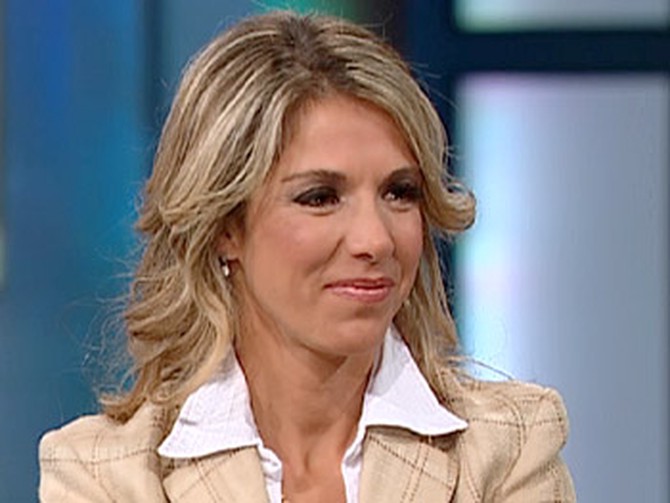
Instead of telling a dog "no" when it's doing something wrong, Tamar makes a high-pitched noise that she calls the "shrieking dolphin." "I don't believe in saying no to a dog. I believe in doing it like a mental diet on focusing on what is the yes," Tamar says. "But every once in a while you need to let your dog know they're doing something wrong."
Tamar makes a noise with her throat that sounds like a dolphin. "And that dog goes, like, 'What just happened?' And, voom, he's there and I can redirect him to what I want him to do," she says.
Tamar makes a noise with her throat that sounds like a dolphin. "And that dog goes, like, 'What just happened?' And, voom, he's there and I can redirect him to what I want him to do," she says.

Barking is one of the most common complaints from dog owners and their neighbors. Tamar helps Scout, a West Highland terrier, curb his yapping. When Scout starts barking, Tamar distracts him. She startles Scout into silence with one squirt of water from a spray bottle, saying, "That's a good shush." Then, she gives Scout a treat to reinforce the fact that it's good to quiet down. The next time he starts barking, Scout only has to see the water bottle to stop.
With a little practice, Scout learns to shush when told. "The force that drives a dog with any behavior is what they associate with pain and pleasure. He was associating a lot of pleasure with barking. I needed to change that," Tamar says. "So giving him the surprise spritz with water was, like, 'Ooh, I don't like that.'"
Using different voice levels can also help quiet a barking dog. "Your voice is one of the best tools you can have of communicating if you're happy or not happy with them," she says.
With a little practice, Scout learns to shush when told. "The force that drives a dog with any behavior is what they associate with pain and pleasure. He was associating a lot of pleasure with barking. I needed to change that," Tamar says. "So giving him the surprise spritz with water was, like, 'Ooh, I don't like that.'"
Using different voice levels can also help quiet a barking dog. "Your voice is one of the best tools you can have of communicating if you're happy or not happy with them," she says.
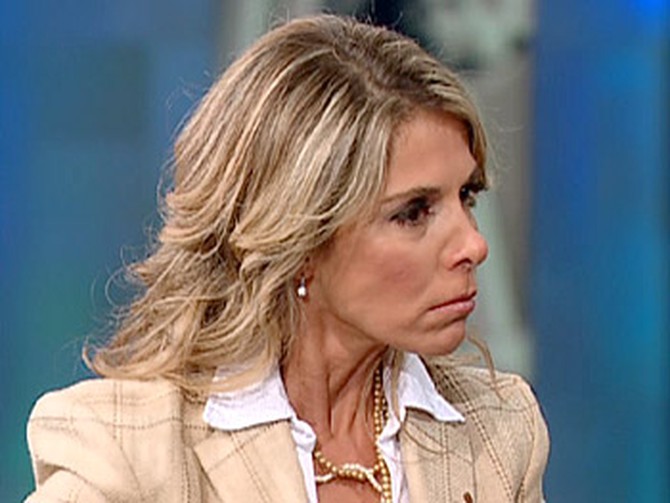
As Tamar was training Luke, the pup made a break for the gate and ran out into the street. Because he could have been hit by a car, Tamar decided to teach him a lesson. "It was important not to mince words and to let him know that I'm [not] very happy and to have him associate a lot of pain with that experience," Tamar says.
Tamar started by recreating the situation so she would have control. She put on a disguise—a cowboy hat, a big jacket and boots—so that Luke wouldn't recognize her. She stood just outside the gate, fawning over another dog. "Luke couldn't take it and at one point he came out," Tamar says.
That's when Tamar says she "went wolf" on Luke. "I kind of mimic what wolves do in nature. When they want to be threatening, they raise their hackles, the ears go up, they become very stiff and try to look as big as possible. They focus on you with [an] I'm-gonna-kill-you look and they're almost, like, not breathing," Tamar says.
Without getting physical, Tamar tensed up and screamed, "No, wait!" That got Luke's attention. "You really have to go to town to let the dog know what you mean," she says. "He was like, 'Oops. I never hear her screaming at me. I better go run back home." The moment Luke returned to where he was supposed to be, Tamar used a loving tone of voice to reward him. "That's why you want to make ... your tone of voice to be relevant," she says. "You don't want to be all the time the same."
Tamar started by recreating the situation so she would have control. She put on a disguise—a cowboy hat, a big jacket and boots—so that Luke wouldn't recognize her. She stood just outside the gate, fawning over another dog. "Luke couldn't take it and at one point he came out," Tamar says.
That's when Tamar says she "went wolf" on Luke. "I kind of mimic what wolves do in nature. When they want to be threatening, they raise their hackles, the ears go up, they become very stiff and try to look as big as possible. They focus on you with [an] I'm-gonna-kill-you look and they're almost, like, not breathing," Tamar says.
Without getting physical, Tamar tensed up and screamed, "No, wait!" That got Luke's attention. "You really have to go to town to let the dog know what you mean," she says. "He was like, 'Oops. I never hear her screaming at me. I better go run back home." The moment Luke returned to where he was supposed to be, Tamar used a loving tone of voice to reward him. "That's why you want to make ... your tone of voice to be relevant," she says. "You don't want to be all the time the same."

Dr. Marty Goldstein, author of The Nature of Animal Healing, is an expert on holistic pet medicine and the veterinarian caring for Oprah's dog Sophie, who is suffering from kidney failure. Based on Dr. Marty's advice, Oprah says she now feeds her dogs a mixed diet of chicken, beef, lamb, brown rice, potatoes and carrots.
Dr. Marty says most people feed their dogs diets that go against their animal nature. He says a dog that eats only dry food is like a person who eats nothing but carbs!
Dr. Marty says the best thing for a dog to eat is raw meat. Dr. Marty says his own dog, Danny, ate this diet and lived to be 19! "Danny lived on fresh cooked meat and brown rice and carrots, peas, lamb, potatoes. You know, real food. What did they eat in nature? They ate real food."
To get Dr. Marty's advice on what to feed your pet, visit his website.
Dr. Marty says most people feed their dogs diets that go against their animal nature. He says a dog that eats only dry food is like a person who eats nothing but carbs!
Dr. Marty says the best thing for a dog to eat is raw meat. Dr. Marty says his own dog, Danny, ate this diet and lived to be 19! "Danny lived on fresh cooked meat and brown rice and carrots, peas, lamb, potatoes. You know, real food. What did they eat in nature? They ate real food."
To get Dr. Marty's advice on what to feed your pet, visit his website.
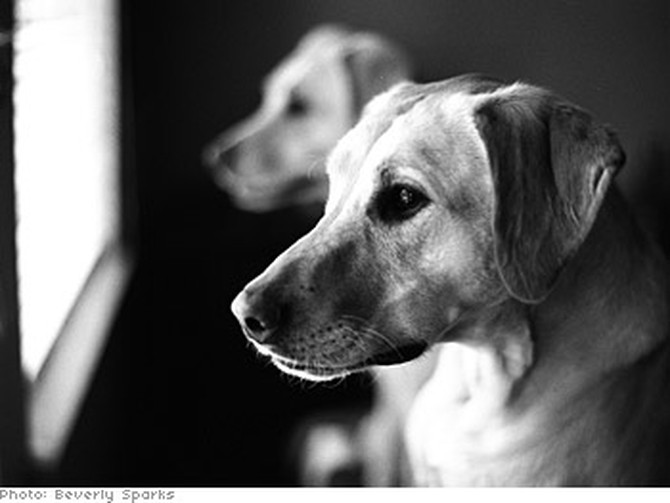
The photographs displayed on set were taken by Beverly Sparks, a photographer who uses playful sessions to capture an animal's true personality on film.
Meet the dogs of the rich and famous!
Meet the dogs of the rich and famous!
Published 01/01/2006

